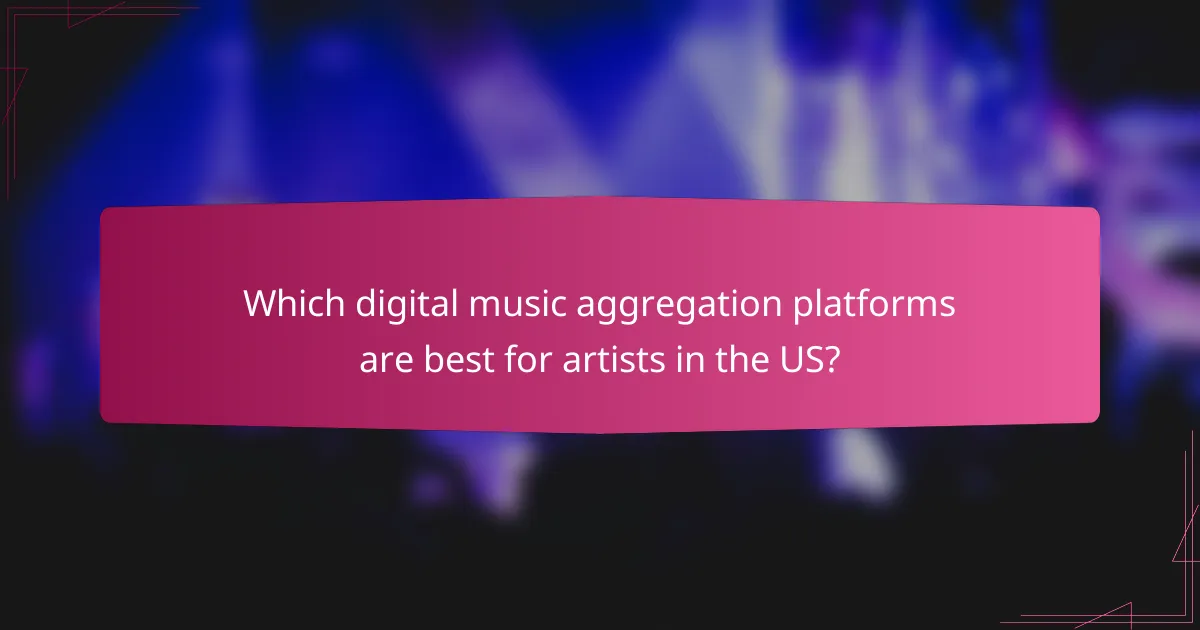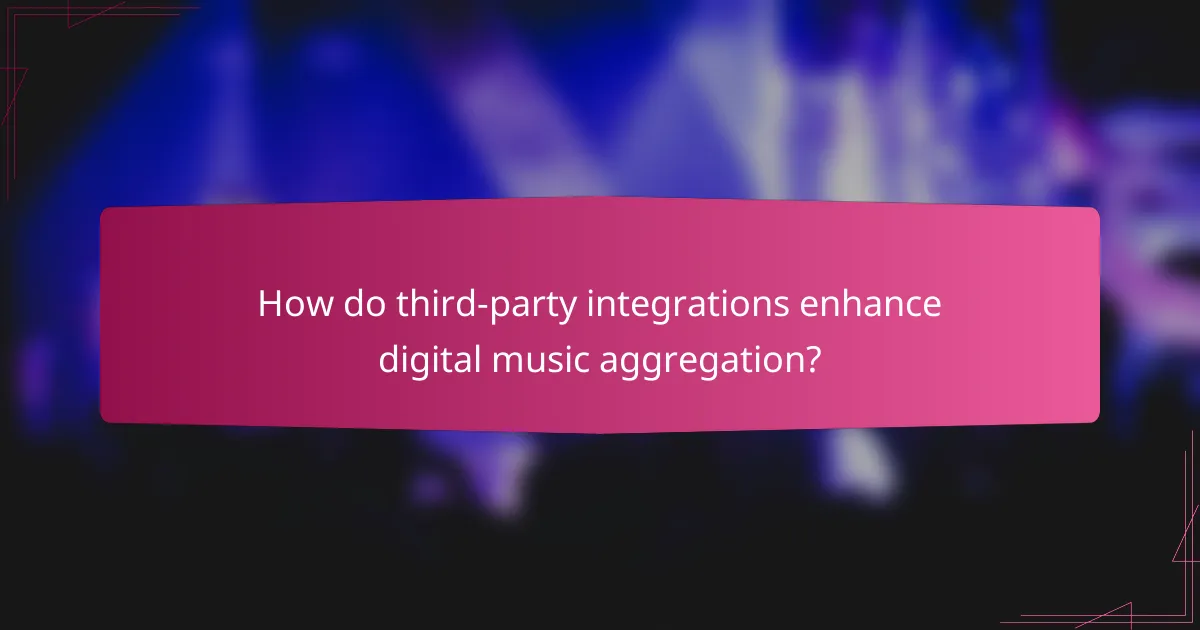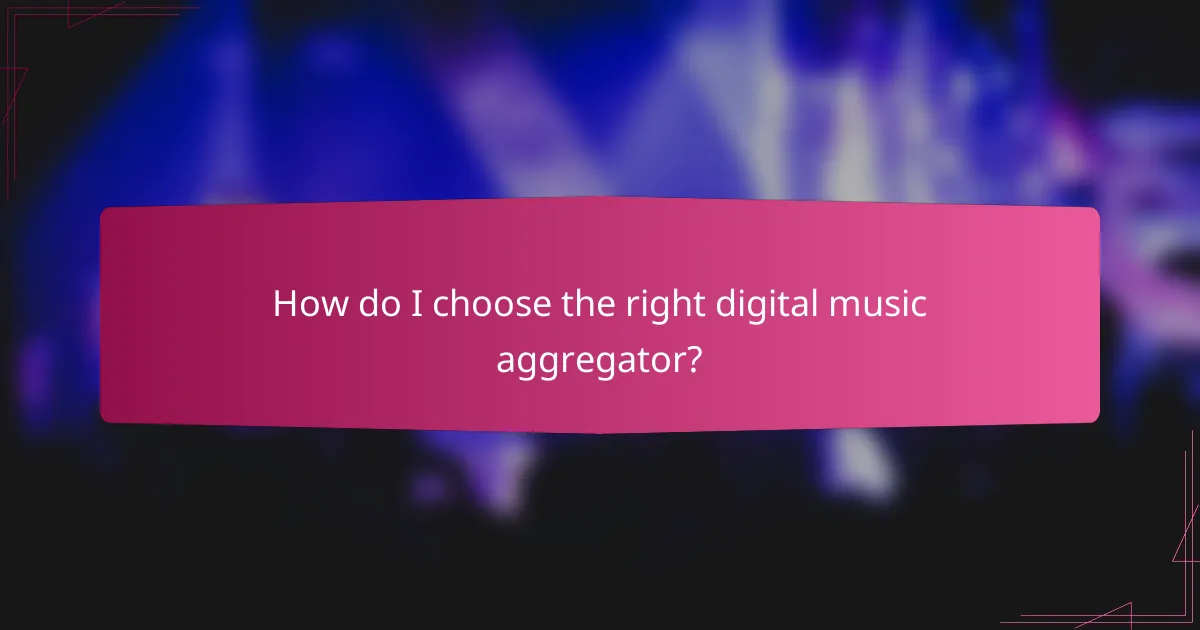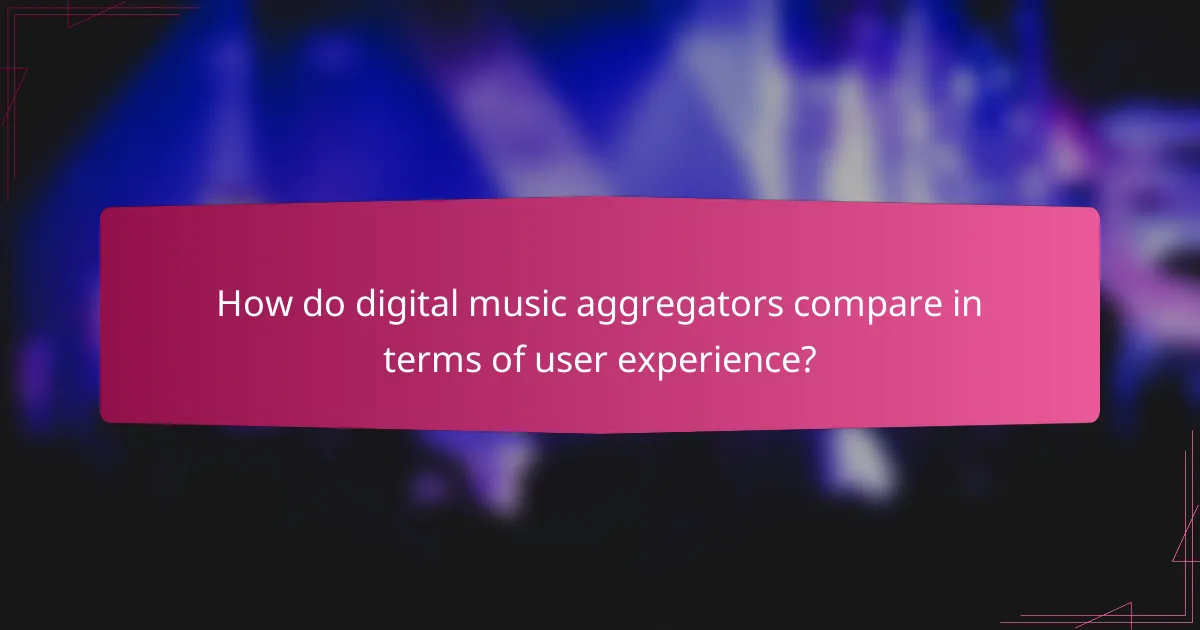Digital music aggregation platforms play a crucial role for artists seeking to distribute their music effectively. By comparing third-party integrations, we can identify how these platforms enhance functionality, streamline processes, and improve overall management of music distribution and analytics. Understanding the unique features of key players like DistroKid, CD Baby, and TuneCore can help artists choose the best fit for their needs.

Which digital music aggregation platforms are best for artists in the US?
For artists in the US, the best digital music aggregation platforms are those that offer a balance of affordability, ease of use, and extensive distribution networks. Key players like DistroKid, CD Baby, and TuneCore each have unique features that cater to different needs and preferences.
DistroKid
DistroKid is known for its straightforward pricing model, allowing artists to upload unlimited music for a flat annual fee. This can be particularly beneficial for prolific musicians who release multiple tracks or albums each year.
One of the standout features of DistroKid is its fast distribution process, often getting music onto platforms like Spotify and Apple Music within a few days. However, artists should be aware that DistroKid takes a percentage of earnings from certain services, so it’s essential to review the terms carefully.
CD Baby
CD Baby operates on a pay-per-release model, charging artists a one-time fee for each album or single uploaded. This can be advantageous for those who release music less frequently and prefer to avoid annual fees.
CD Baby also offers additional services such as physical distribution and sync licensing, which can help artists reach broader audiences. However, the upfront costs can add up, especially for artists planning multiple releases in a year.
TuneCore
TuneCore provides a similar pay-per-release model but also includes annual fees for maintaining music on platforms. This can be a consideration for artists who want to keep their music available long-term.
One of TuneCore’s strengths is its detailed analytics, which help artists track their sales and streaming data across various platforms. While the fees can be higher than some competitors, the insights gained can be valuable for marketing and future releases.

How do third-party integrations enhance digital music aggregation?
Third-party integrations significantly enhance digital music aggregation by streamlining processes and automating tasks. These tools connect various platforms, allowing artists and labels to manage their music distribution, royalties, and analytics more efficiently.
Streamlined distribution
Streamlined distribution through third-party integrations simplifies the process of getting music onto multiple streaming platforms. By using a single dashboard, artists can distribute their tracks to services like Spotify, Apple Music, and Amazon Music simultaneously, saving time and effort.
For example, platforms like DistroKid and TuneCore allow users to upload their music once and select multiple distribution channels. This approach reduces the risk of errors and ensures that all platforms are updated with the latest releases quickly.
Automated royalty collection
Automated royalty collection is another key benefit of third-party integrations, ensuring that artists receive payments without manual tracking. These integrations can automatically gather data from various streaming services and calculate earnings based on plays and downloads.
Services like SoundExchange and CD Baby provide tools that help artists track their royalties in real-time, making it easier to understand their income streams. By automating this process, artists can focus more on creating music rather than managing finances, leading to better overall productivity.

What are the key features of popular digital music aggregation platforms?
Popular digital music aggregation platforms offer essential features that facilitate the distribution and management of music across various streaming services. Key functionalities include analytics and reporting, social media integration, and customizable release options, which help artists and labels optimize their music’s reach and performance.
Analytics and reporting
Analytics and reporting features provide insights into how music is performing across different platforms. These tools typically track metrics such as streams, downloads, and listener demographics, allowing artists to understand their audience better.
When choosing a platform, consider the depth of analytics offered. Some platforms provide real-time data, while others may offer weekly or monthly reports. Look for features like geographic breakdowns and engagement statistics to tailor your marketing efforts effectively.
Social media integration
Social media integration allows artists to promote their music directly through platforms like Facebook, Instagram, and Twitter. This feature helps in building a fanbase and driving traffic to streaming services.
Effective integration can include automated posting of new releases, sharing of analytics, and fan engagement tools. Ensure the platform supports the social media channels most relevant to your audience to maximize your promotional efforts.
Customizable release options
Customizable release options enable artists to control how and when their music is distributed. This includes setting specific release dates, choosing between singles or albums, and deciding on pre-release strategies.
Look for platforms that allow flexibility in release scheduling and offer options for exclusive content or early access for fans. This can enhance engagement and create buzz around new music, ultimately leading to higher initial streams and downloads.

What are the pricing models for digital music aggregation services?
Digital music aggregation services typically employ various pricing models that can significantly impact artists and labels. Understanding these models—subscription-based pricing, one-time fees, and revenue share arrangements—helps in choosing the right service for distributing music effectively.
Subscription-based pricing
Subscription-based pricing involves paying a recurring fee, usually monthly or annually, to access the aggregation service. This model is popular among independent artists and labels, as it often provides unlimited uploads and distribution across multiple platforms for a fixed cost.
Costs for subscription services can range from around $10 to $50 per month, depending on the features offered. Some platforms may also offer tiered pricing, where higher tiers provide additional benefits like enhanced analytics or promotional tools.
One-time fees
One-time fees require users to pay a single upfront cost for each release or album they wish to distribute. This model can be appealing for artists who release music infrequently or prefer not to commit to ongoing payments.
Typically, one-time fees can vary widely, often falling between $10 and $100 per release. While this may seem cost-effective for occasional releases, artists should consider the potential for higher long-term costs if they plan to distribute multiple projects.
Revenue share models
Revenue share models involve the aggregation service taking a percentage of the earnings generated from music sales and streams. This approach aligns the interests of the aggregator and the artist, as both parties benefit from successful releases.
Common revenue shares range from 10% to 30% of the artist’s earnings. While this model can reduce upfront costs, artists should carefully evaluate how these percentages impact their overall income, especially if they anticipate high sales volumes.

How do I choose the right digital music aggregator?
Choosing the right digital music aggregator involves evaluating key factors such as distribution reach, customer support, and pricing. Prioritize platforms that align with your specific needs as an artist or label, ensuring they effectively distribute your music to the desired streaming services and provide reliable assistance.
Assessing distribution reach
Distribution reach is crucial when selecting a digital music aggregator. Look for platforms that distribute to a wide array of streaming services, including popular ones like Spotify, Apple Music, and Amazon Music. Some aggregators may offer additional channels such as TikTok or YouTube, which can enhance your visibility.
Consider the geographical coverage as well. If you aim to reach audiences in specific regions, ensure the aggregator has partnerships with local services. For example, if you’re targeting Eastern Europe, check if they distribute to platforms popular in that area.
Evaluating customer support
Reliable customer support is essential for resolving issues that may arise during the distribution process. Assess the support options available, such as email, chat, or phone assistance, and their response times. Some aggregators provide dedicated account managers for personalized support, which can be beneficial.
Additionally, read reviews or testimonials from other users to gauge the quality of customer service. Look for platforms that offer comprehensive resources, such as FAQs and tutorials, which can help you navigate the aggregator’s features more effectively.

What are the common challenges faced by artists using aggregation platforms?
Artists using digital music aggregation platforms often encounter challenges such as complex navigation and delayed royalty payments. These issues can hinder their ability to effectively distribute music and receive timely compensation.
Complexity of platform navigation
Navigating aggregation platforms can be overwhelming due to their extensive features and interfaces. Many artists struggle to find essential tools for uploading music, managing metadata, or tracking performance analytics.
To simplify navigation, artists should familiarize themselves with the platform’s layout and available resources. Utilizing tutorials or support forums can provide valuable insights and help avoid common pitfalls.
Delayed royalty payments
Delayed royalty payments are a frequent issue for artists using aggregation services. Payment timelines can vary significantly, often taking several months after a release before artists see any earnings.
Artists should carefully review the payment terms of their chosen platform, as some may have more favorable conditions than others. Keeping track of release dates and expected payment schedules can help manage expectations and cash flow.

How do digital music aggregators compare in terms of user experience?
Digital music aggregators vary significantly in user experience, impacting how artists and labels manage their music distribution. Key factors include ease of use, interface design, and available support, which can greatly influence an artist’s workflow and satisfaction.
User interface design
User interface design plays a crucial role in the overall experience of digital music aggregators. A well-designed interface should be intuitive, allowing users to navigate easily through features such as uploading tracks, managing releases, and tracking analytics. For example, platforms like DistroKid offer a straightforward layout that minimizes the learning curve for new users.
When evaluating interface design, consider the organization of tools and features. Look for platforms that prioritize user-friendly navigation and provide clear instructions or tutorials. Some aggregators may offer customizable dashboards, which can enhance user experience by allowing artists to focus on the metrics that matter most to them.
Common pitfalls include overly complex interfaces that can confuse users or obscure important features. Before committing to a platform, explore demo versions or user reviews to gauge the effectiveness of its design in real-world scenarios.
